The second smallest state in America, Delaware is only about twice the size of Rhode Island. But despite its tiny size, Delaware hosts around 400 species of birds, and 15 of them are sparrows.
The varied landscapes in Delaware offer homes for different types of sparrow, including species that prefer salt marsh and coastal habitats. Some of them come here exclusively for breeding or overwintering, while others remain here all year round.
Many of these cheerful little brown birds can be attracted to backyards by offering them bird feeders and bird baths. This is also one of the best ways to get a closer look at them and get to know each species.
Thankfully many sparrows also have distinctive songs, so getting to know how they sound is another brilliant way to recognize them. With a bit of practise, learning how to identify sparrows can take your bird watching skills to the next level.
Here is a list of 13 resident sparrows, as well as a couple of sparrow species that pass through Delaware during the migratory season.
Resident Sparrows in Delaware, Starting With the Most Common
Song Sparrow

- Scientific Name: Melospiza melodia
- Length: 4.7-6.7 in (12-17 cm)
- Weight: 0.4-1.9 oz (12-53 g)
- Wingspan: 7.1-9.4 in (18-24 cm)
Not surprisingly, song sparrows are famous for being one the most vocal sparrows. While some people don’t find their song the most tuneful, it is a cheerful backdrop that can be enjoyed almost constantly during the spring and summer.
Since they look so similar to many other sparrows, their song, once learned, is also one of the best ways to identify this common bird.
Song sparrows are a frequent sight in Delaware during the breeding season but become even more numerous during the winter. It’s easy to attract them to your backyard feeder by offering them cracked corn, black oil sunflower seeds, and other types of seeds and grains.
House Sparrow
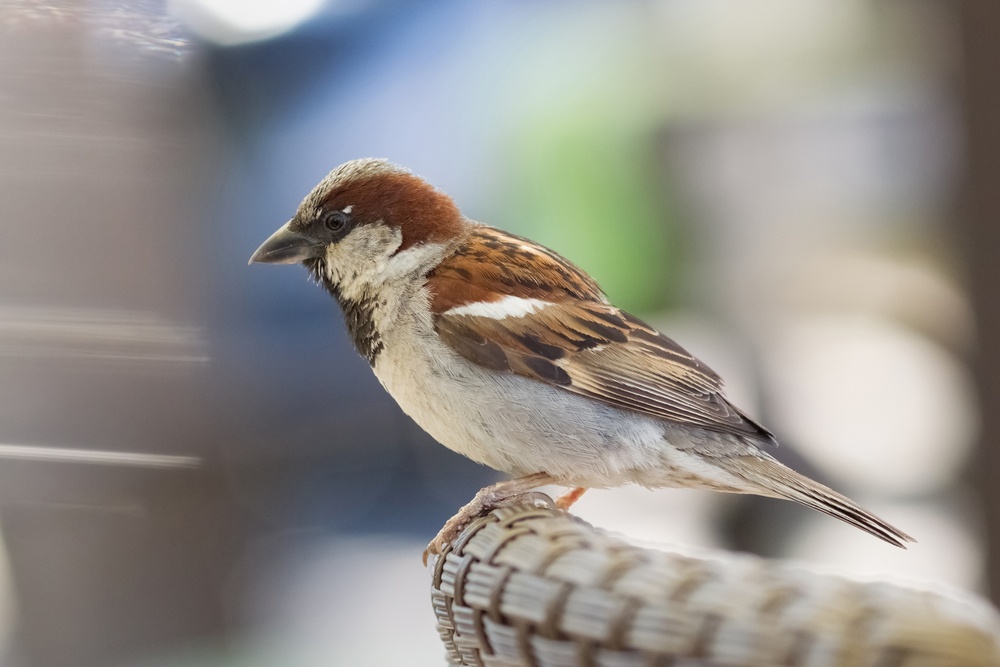
- Scientific Name: Passer domesticus
- Length: 5.9-6.7 in (15-17 cm)
- Weight: 0.9-1.1 oz (27-30 g)
- Wingspan: 7.5-9.8 in (19-25 cm)
House sparrows are not native to the US and were introduced to New York City in 1852 from Europe. They quickly spread and now can be found right across the USA and Southern Canada.
Because they’re not related to native sparrows, house sparrows behave quite differently. They don’t migrate and tend to stick to the same territories throughout the year.
Since they sometimes dominate the nesting grounds of native birds, some ornithologists consider house sparrows to be a pest. They are, however, one of the tamest and most endearing sparrows, and can even be trained to eat from your hand!
Eastern Towhee

- Scientific Name: Pipilo erythrophthalmus
- Length: 6.8-8.2 in (17.3-20.8 cm)
- Weight: 1.1-1.8 oz (32-52 g)
- Wingspan: 7.9-11.0 in (20-28 cm)
Large, chunky, and colorful, the Eastern towhee is perhaps the most visually distinctive of all sparrows in Delaware. Their striking jet-black upper body, white chest, rusty red flanks, and long tail make this bird unmistakable.
Although you may not think of towhees as sparrows, they are as much a part of the New World Sparrow family as any other bird on our list.
Delaware is right at the northernmost part of the Eastern Towhee’s wintering range, and these birds are much more commonly seen here during the spring and summer than in winter. You can help these birds through the cold winter weather by offering them nuts and seeds at your backyard feeder.
Dark-eyed Juncos
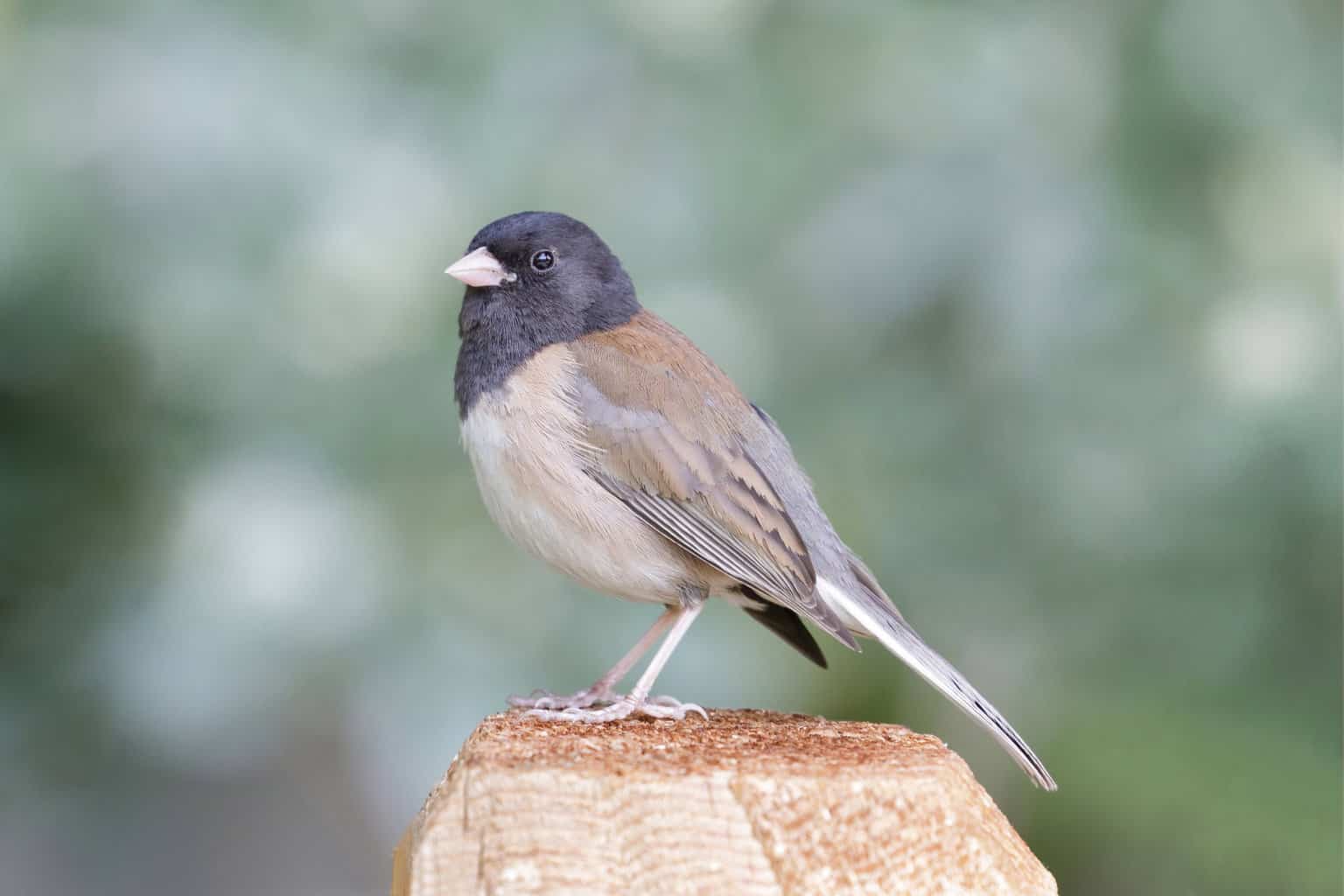
- Scientific Name: Junco hyemalis
- Length: 5.5-6.3 in (14-16 cm)
- Weight: 0.6-1.1 oz (18-30 g)
- Wingspan: 7.1-9.8 in (18-25 cm)
Dark-eyed juncos are fairly large sparrows that have varying plumage depending on which part of America they live in. On the east coast, almost all of them are of the ‘slate-colored’ variety, which perfectly describes the shade of their gray plumage.
Delaware is merely a wintering ground for the dark-eyed junco, a bird whose nickname, the ‘snowbird’, indicates how hardy they are. They mostly breed in Canada and Alaska.
These birds are enthusiastic visitors to backyard feeding stations, meaning you’re almost certain to see them if you offer them black oil sunflower seeds, millet, and even peanuts.
Chipping Sparrow
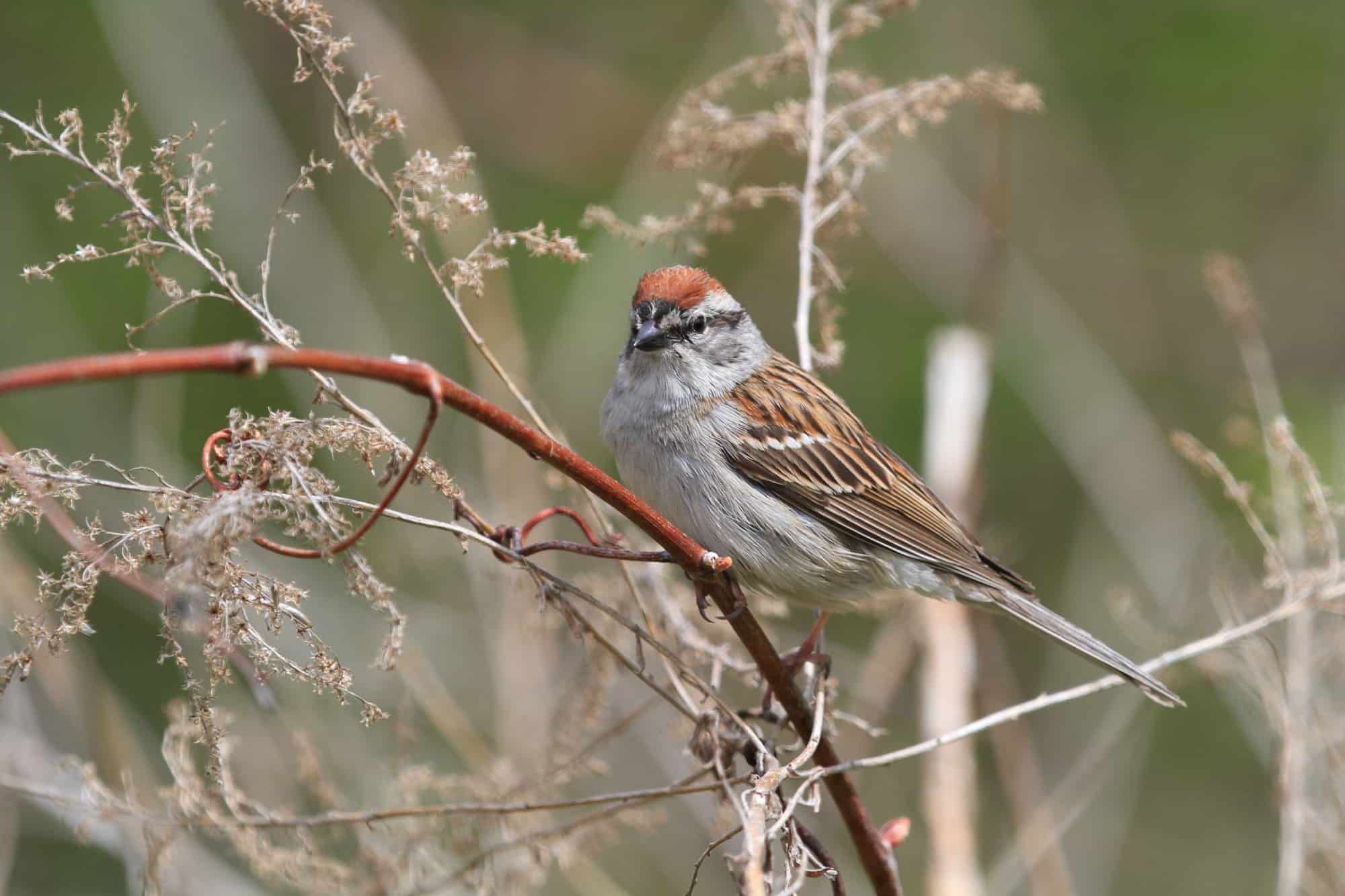
- Scientific Name: Spizella passerina
- Length: 4.7-5.9 in (12-15 cm)
- Weight: 0.4-0.6 oz (11-16 g)
- Wingspan: 8.3 in (21 cm)
Chipping sparrows are named after their noisy ‘chipping’ and chattering. They’re also fairly easy to identify by the rusty red streak on their head, gray underside, and black eye lines.
Chipping sparrows are a very common sighting in Delaware during the breeding season, they’re fairly rare here in the colder months when they prefer to overwinter further south.
They build their nests out of dried grass and roots and can raise three broods in a single season!
Field Sparrow
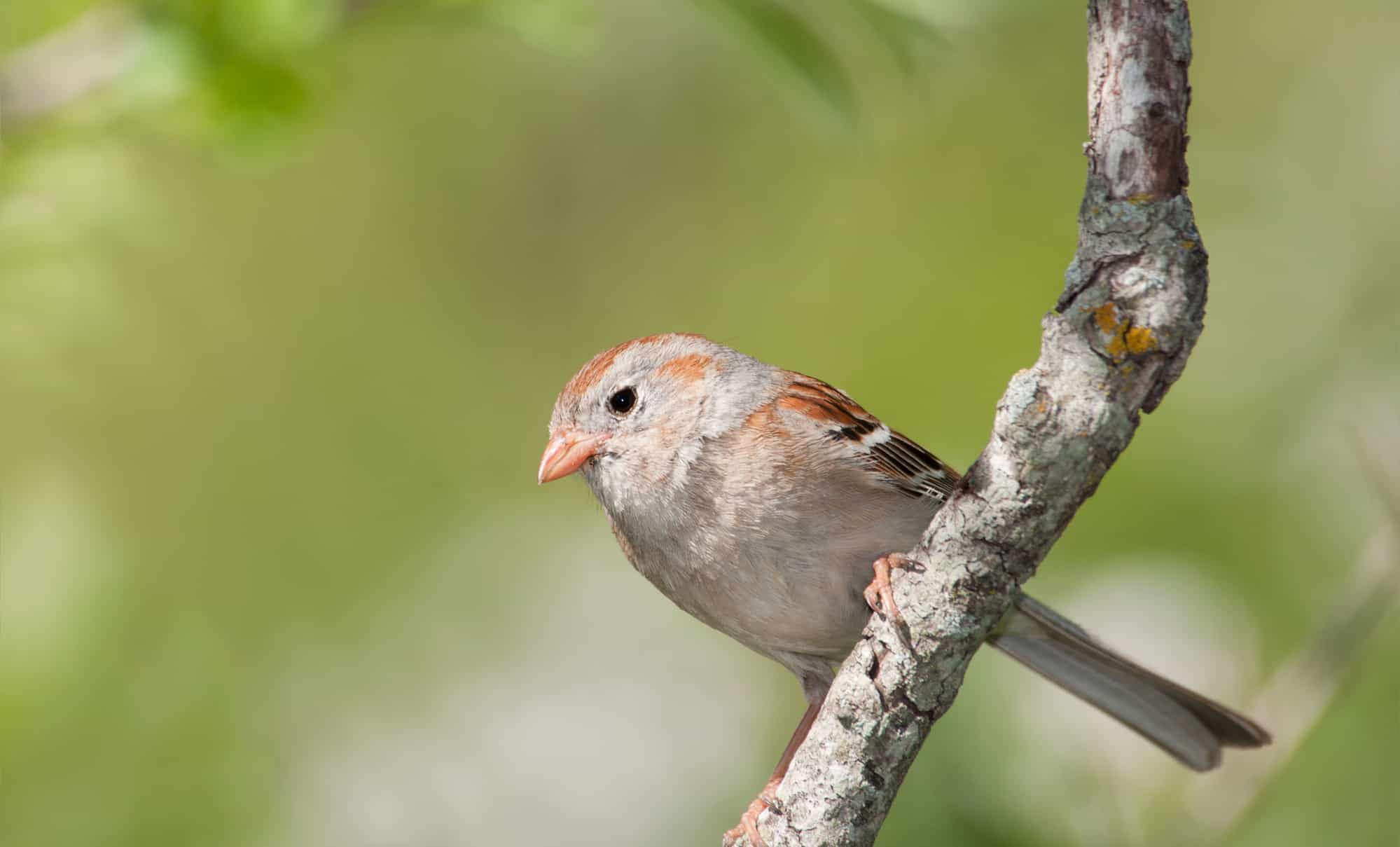
- Scientific Name: Spizella pusilla
- Length: 4.7-5.9 in (12-15 cm)
- Weight: 0.4-0.5 oz (11-15 g)
- Wingspan: 7.9 in (20 cm)
Field sparrows are fairly indistinct, small, brown sparrows. As their name suggests, they prefer life out in the meadows to areas nearby human habitation, and their reclusive nature can make them difficult to spot.
A good way to identify this shy bird is by its high-pitched trill that sounds a bit like a bouncing ball coming to a stop! Males are especially vocal during the breeding season when they’ll often sing from a high perch during the early morning.
These native birds are much more common in Delaware during the summer than in winter, when large numbers of them can be found nesting near the ground. Only a few remain here for the colder months.
Swamp Sparrow
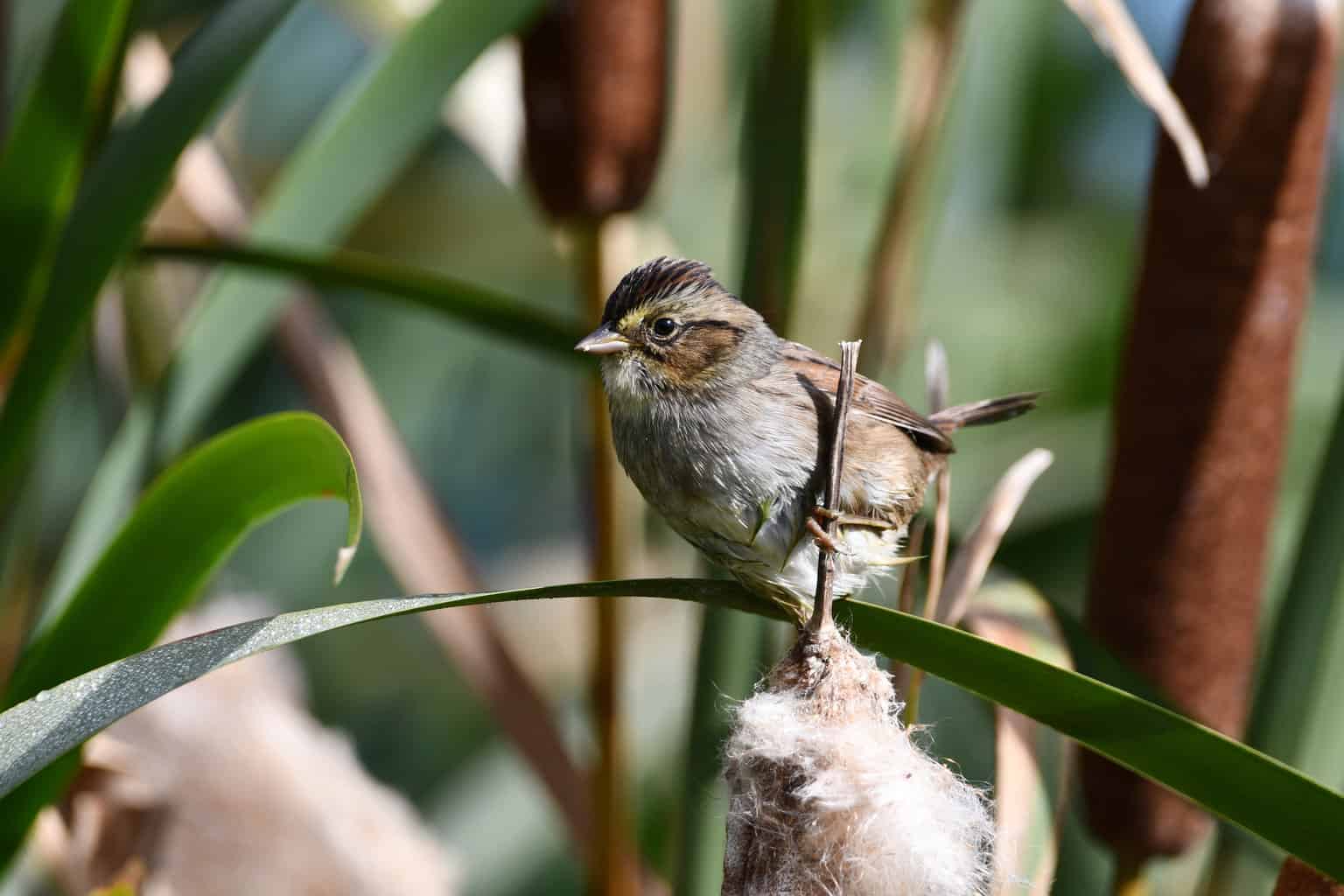
- Scientific Name: Melospiza georgiana
- Length: 4.7-5.9 in (12-15 cm)
- Weight: 0.5-0.8 oz (15-23 g)
- Wingspan: 7.1-7.5 in (18-19 cm)
Swamp sparrows are tiny birds that are most commonly seen around wetlands, coastal marshes, and bogs. As a secretive species, they can be difficult to spot and identify, but a few yellow feathers near their beaks can be seen with a pair of binoculars.
Despite their small size, swamp sparrows have a large migratory range that extends from Central America to Northern Canada. They can occasionally be persuaded to stop off in backyards by offering them a bird bath.
There is only a narrow band of territories where the swamp sparrow can be seen during summer and winter, and this includes Delaware. Still, you’re about twice as likely to see them here in winter than in summer.
Seaside Sparrow
- Scientific Name: Ammospiza maritimus
- Length: 5.1-5.9 in (13-15 cm)
- Weight: 0.7-1.0 oz (19-29 g)
- Wingspan: 7.1-7.9 in (18-20 cm)
The seaside sparrow is another small sparrow species that spends most of its time in coastal marshes. It’s more of a gray color than most sparrows, and it also has a particularly long bill that they use for digging up tasty snacks from deep in the mud!
You can find seaside sparrows along much of the east coast, and in Delaware, they’re mostly seen during the breeding season. They build their nests out of grass among tall, marshy vegetation.
A few seaside sparrows remain in the state throughout the year, but your only decent chance of seeing them in winter is out on the salt marshes with a pair of binoculars.
Fox Sparrow

- Scientific Name: Passerella iliaca
- Length: 5.9-7.5 in (15-19 cm)
- Weight: 0.9-1.6 oz (26-44 g)
- Wingspan: 10.5-11.4 in (26.7-29 cm)
Fox sparrows are one of the largest sparrow species and almost look like a small thrush. Their speckled chest and a reddish tint to their brown feathers make them fairly easy to recognize.
These hardy birds merely use Delaware as an overwintering ground. During the breeding season, they fly to colder regions including the rocky mountains and the arctic circle to nest.
Fox sparrows can be seen scratching about in the undergrowth looking for insects, seeds, and other tasty morsels, much like thrushes do.
White-crowned Sparrow
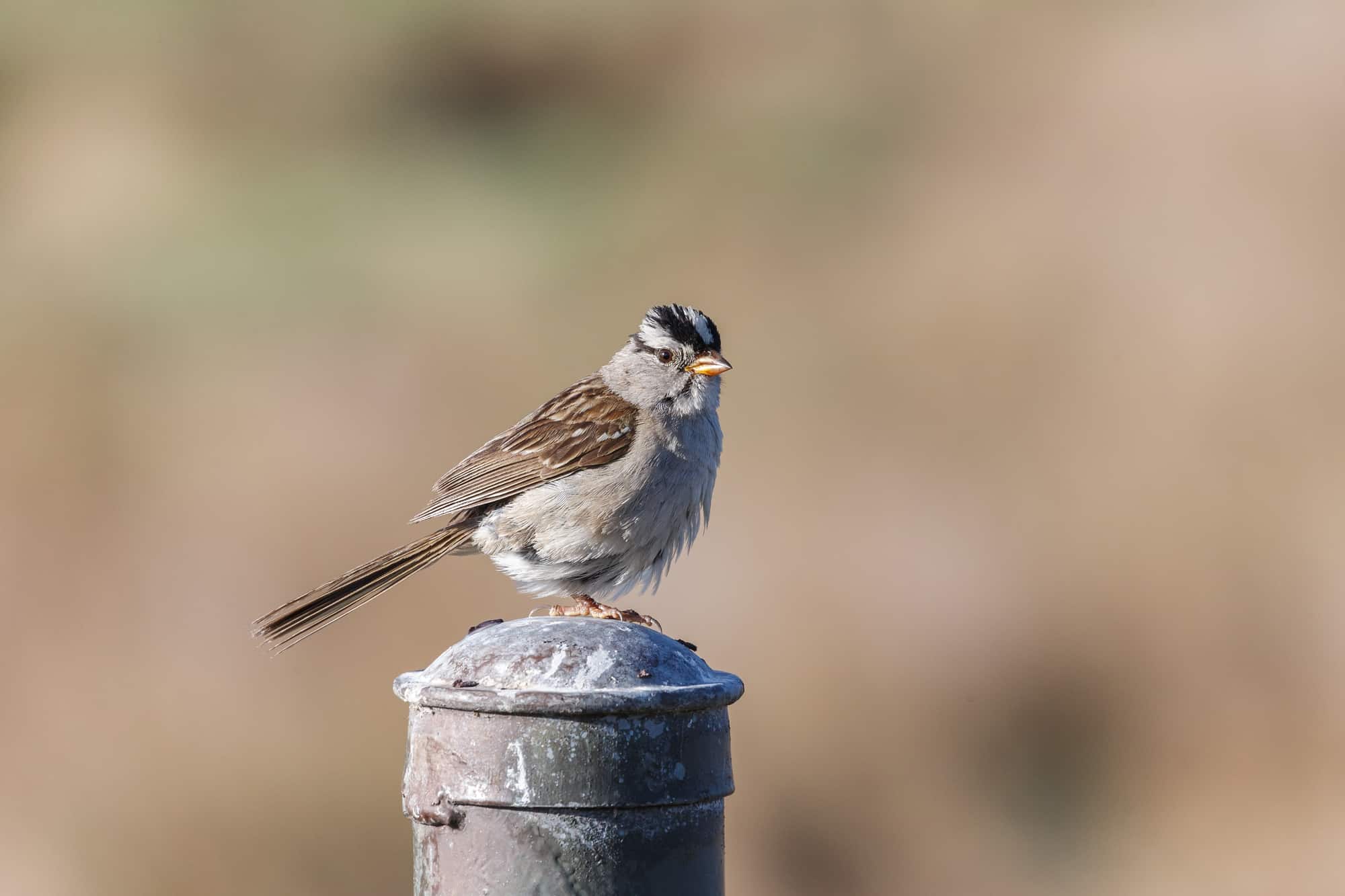
- Scientific Name: Zonotrichia leucophrys
- Length: 5.9-6.3 in (15-16 cm)
- Weight: 0.9-1.0 oz (25-28 g)
- Wingspan: 8.3-9.4 in (21-24 cm)
White-crowned sparrows are fairly large sparrows that are easy to recognize by their black and white striped heads and yellowish bills.
Despite being one the most common sparrows in other states, white-crowned sparrows are a rare sighting in Delaware. The state is right at the northern tip of their wintering range, and they can be seen here between September and May.
You can increase your chances of seeing this species by offering them cracked corn, millet, and other grains at your backyard feeder during the winter months.
American Tree Sparrow
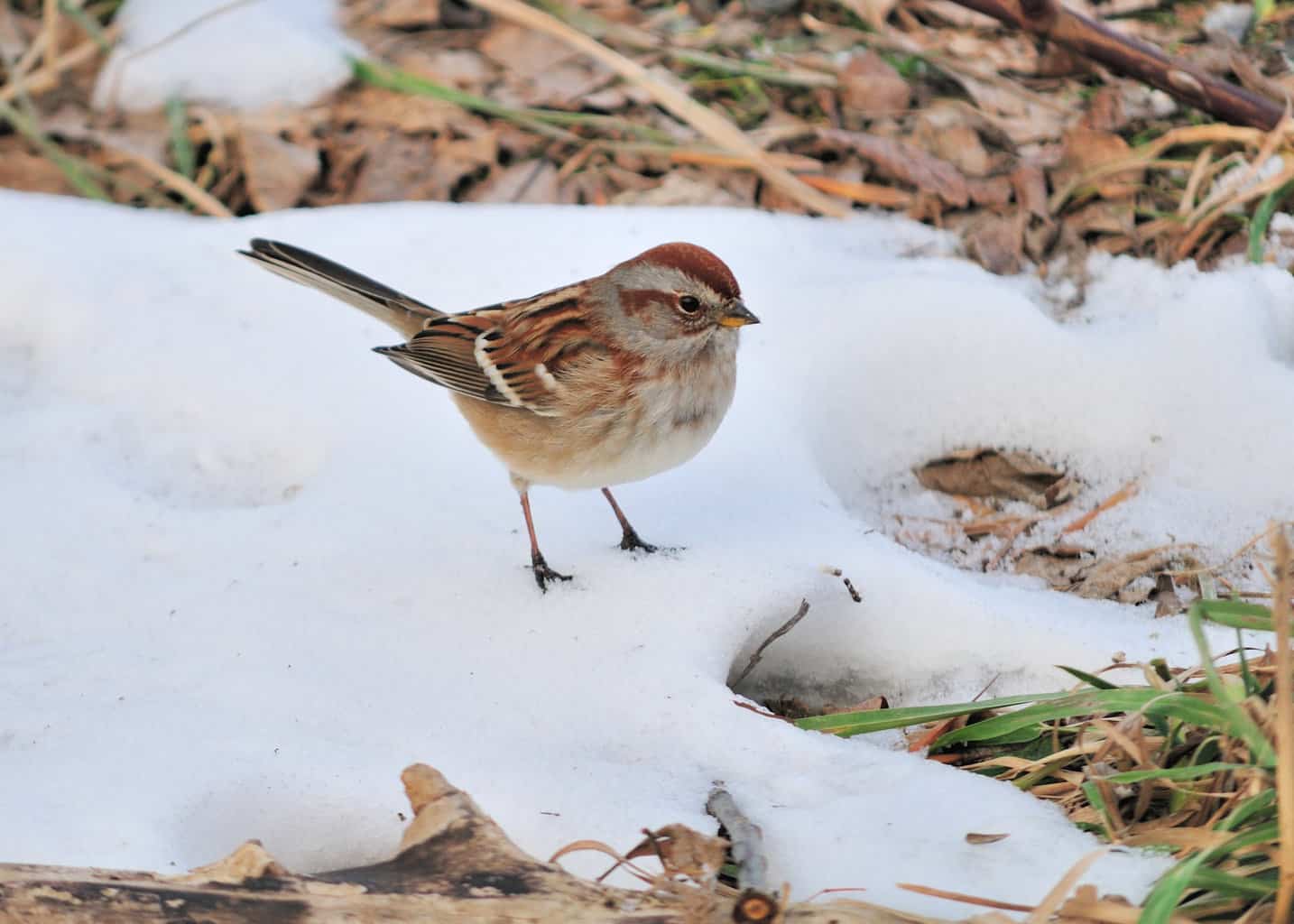
- Scientific Name: Spizelloides arborea
- Length: 5.5 in (14 cm)
- Weight: 0.5-1.0 oz (13-28 g)
- Wingspan: 9.4 in (24 cm)
These medium-large sparrows were named by early European settlers who felt that this bird reminded them of their native tree sparrow. This American species, however, doesn’t live much in trees and is more often found near the ground.
Delaware is near the north of the American tree sparrow’s winter range, and they are a rare sighting here compared to more southerly states. They may be attracted to backyard bird feeders by offering them various seeds.
In summer these birds nest in Northern Canada and Alaska, well into the arctic circle! Listen out for their lovely whistles starting in late winter as they prepare for their voyage north.
Saltmarsh Sparrow
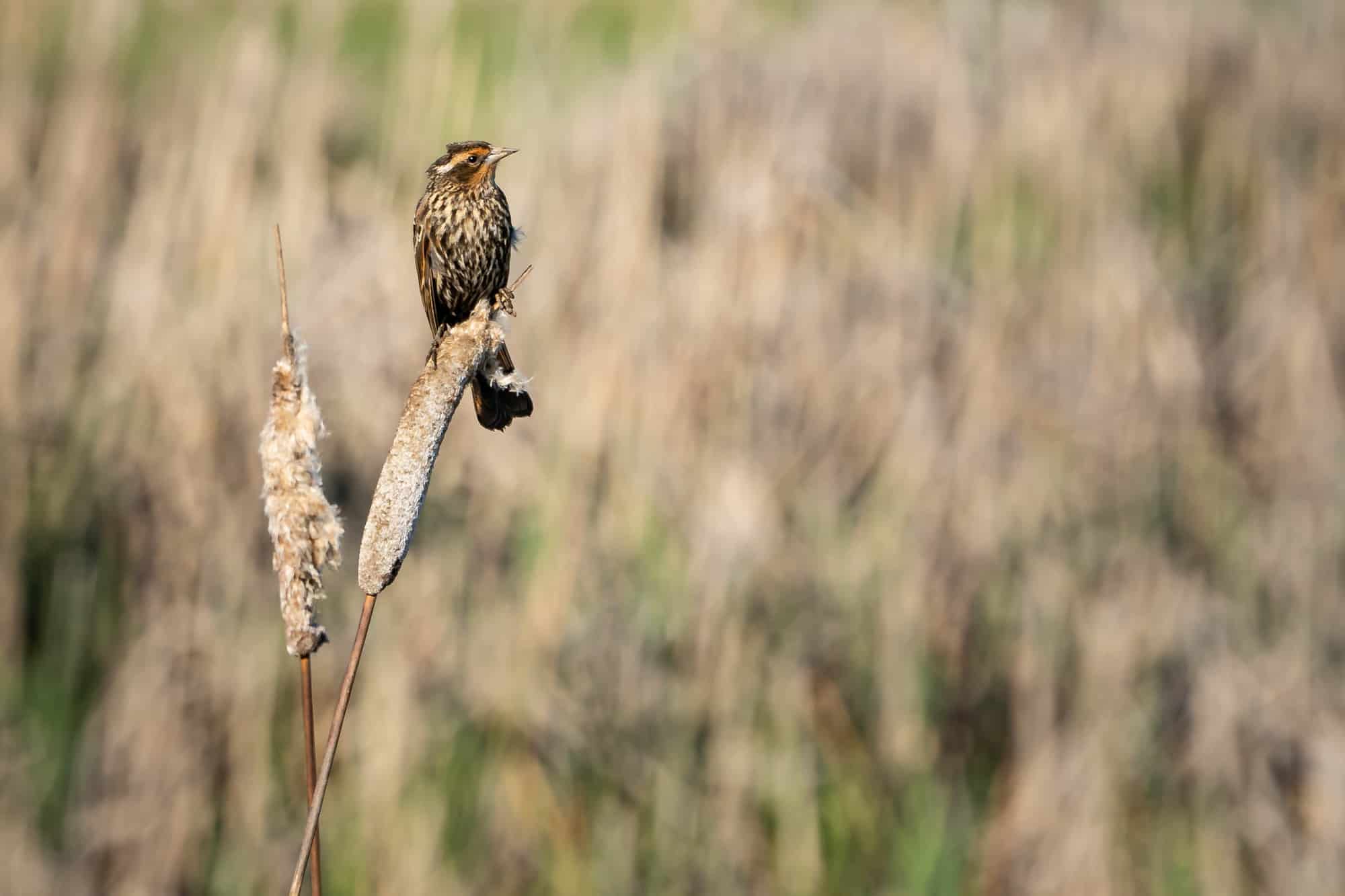
- Scientific Name: Ammospiza caudacuta
- Length: 4.7-5.1 in (12-13 cm)
- Weight: 0.6-0.8 oz (17.1-24.1 g)
- Wingspan: 6.5-7.7 in (16.5-19.5 cm)
Like their cousin the seaside sparrow, the salt marsh sparrow is a small bird that can be found along the eastern coast of North America. They can be told apart from their relative by the orange feathers on their faces.
These birds favor salt marsh habitats and are usually seen in tidal wetlands where they forage for insects and spiders in the mud. Although they can be difficult to approach, a good pair of binoculars is a great tool to accurately identify saltmarsh sparrows in tidal marshes.
In Delaware, saltmarsh sparrows are only occasional summer visitors. They build their nests among reedy plants, sometimes with a dome that helps to keep the nest hidden.
Vesper Sparrow
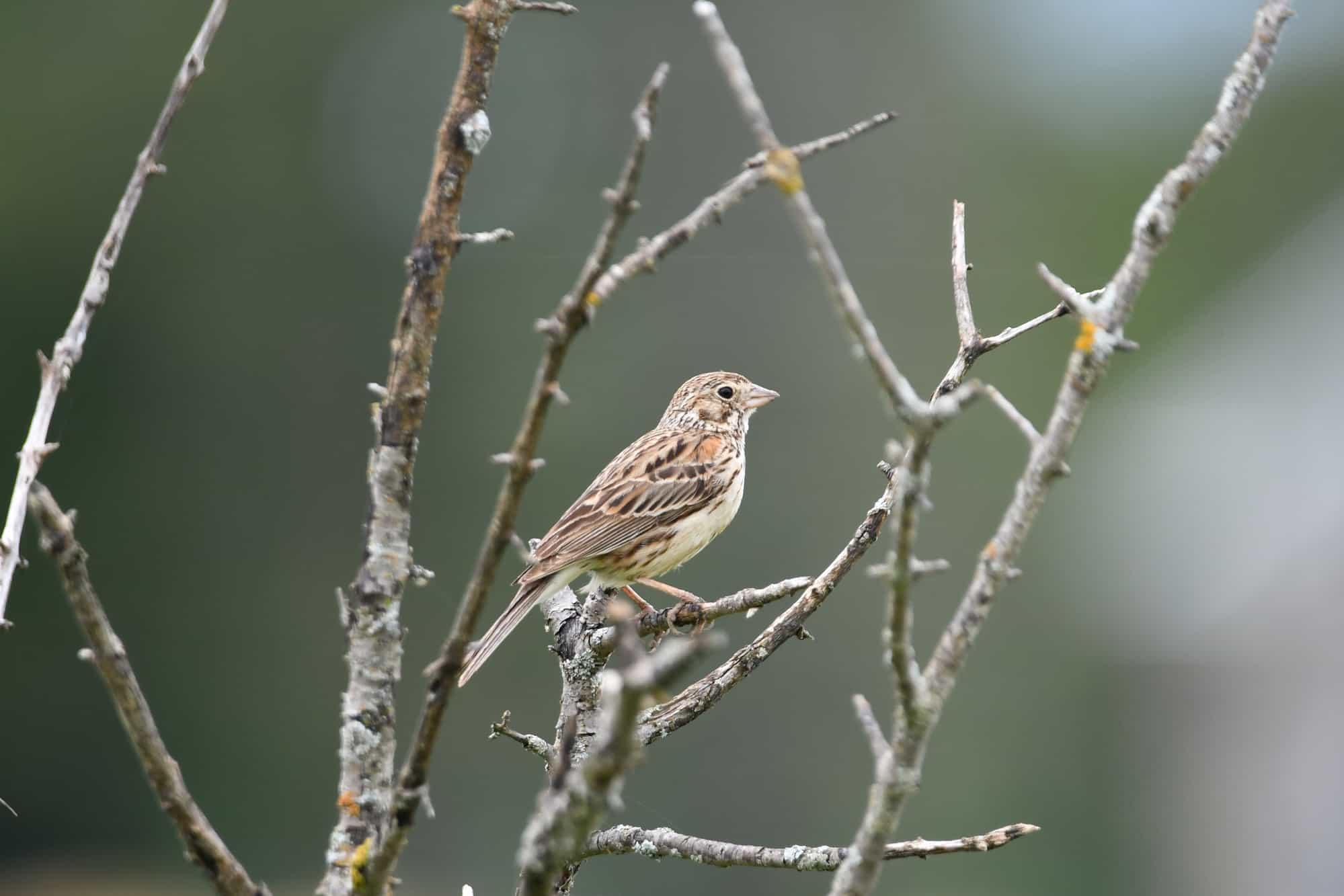
- Scientific Name: Pooecetes gramineus
- Length: 5.1-6.3 in (13-16 cm)
- Weight: 0.7-1.0 oz (20-28 g)
- Wingspan: 9.4 in (24 cm)
Vesper sparrows are closely related to lark sparrows, which are absent in Delaware. One of their distinguishing features is the flash of white feathers that can be seen during flight.
Vesper sparrows are now considered vulnerable in Delaware due to habitat loss. The species used to breed more regularly in the state but is now seen more often as a passing migrant.
Modern agricultural practices are thought to be partly to blame for its demise since this sparrow requires grasslands with high biodiversity to thrive. Conservation efforts will be critical to prevent populations from declining even more.
Sparrows Seen in Delaware During Migration
Most North American sparrows are migratory birds and a couple of species merely pass through Delaware on their flights to and fro their northerly breeding grounds and their southerly wintering grounds during the spring and the fall.
Lincoln’s Sparrow
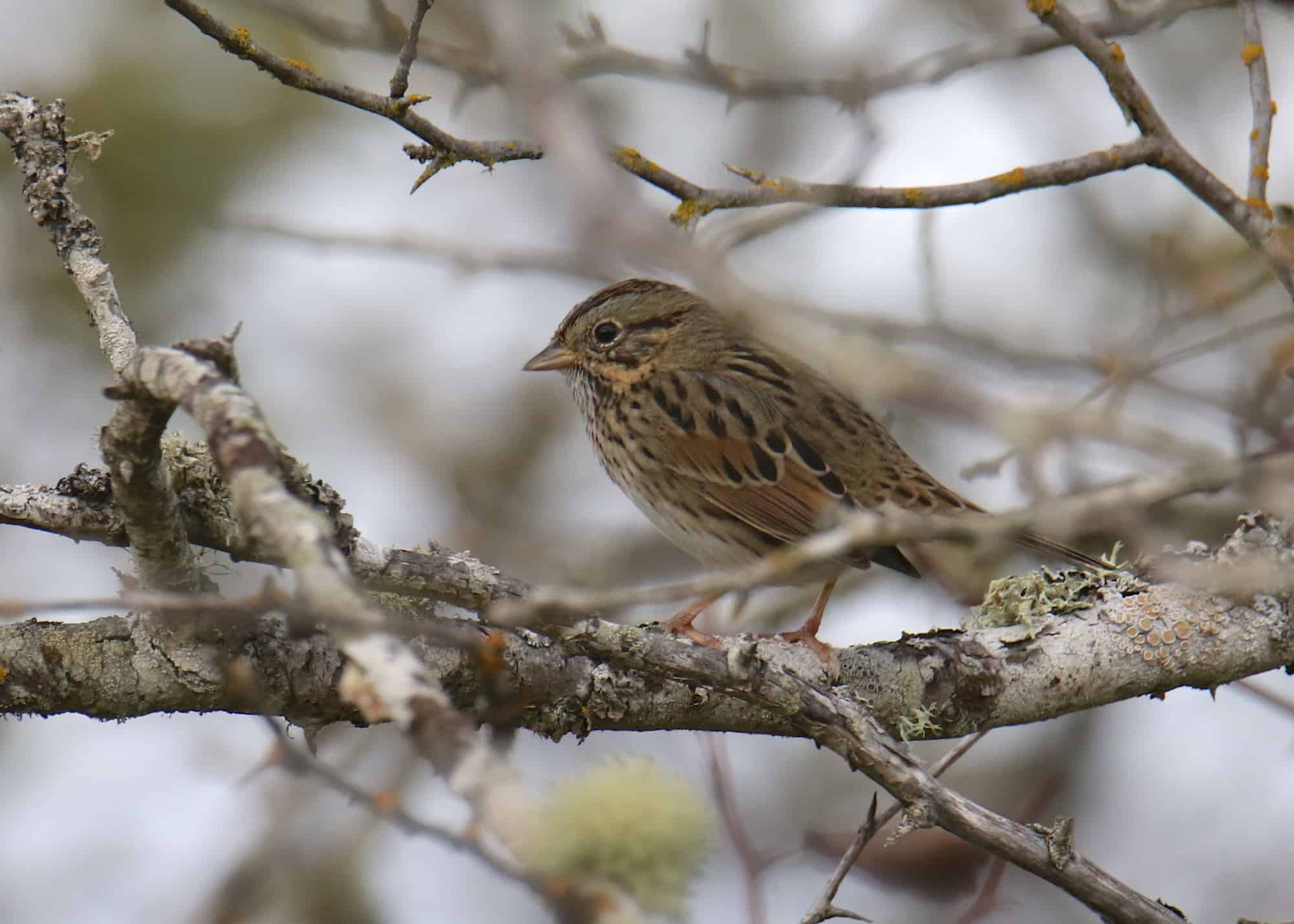
- Scientific Name: Melospiza lincolnii
- Length: 5.1-5.9 in (13-15 cm)
- Weight: 0.6-0.7 oz (17-19 g)
- Wingspan: 7.5-8.7 in (19-22 cm)
The Lincoln’s sparrow might be difficult to recognize by sight but is easily identified by their song, which is one of the sweetest of any sparrow species. You’re more likely to hear it when they pass through on their spring migration rather than in the fall.
Lincoln’s sparrow has a long way to fly every season between its winter grounds in the Southern United States and Central America, to its breeding grounds in the Northern United States and Canada. Delaware is just a brief stop off for these birds can be seen passing through on their long voyage every spring and fall.
Nelson’s Sparrow
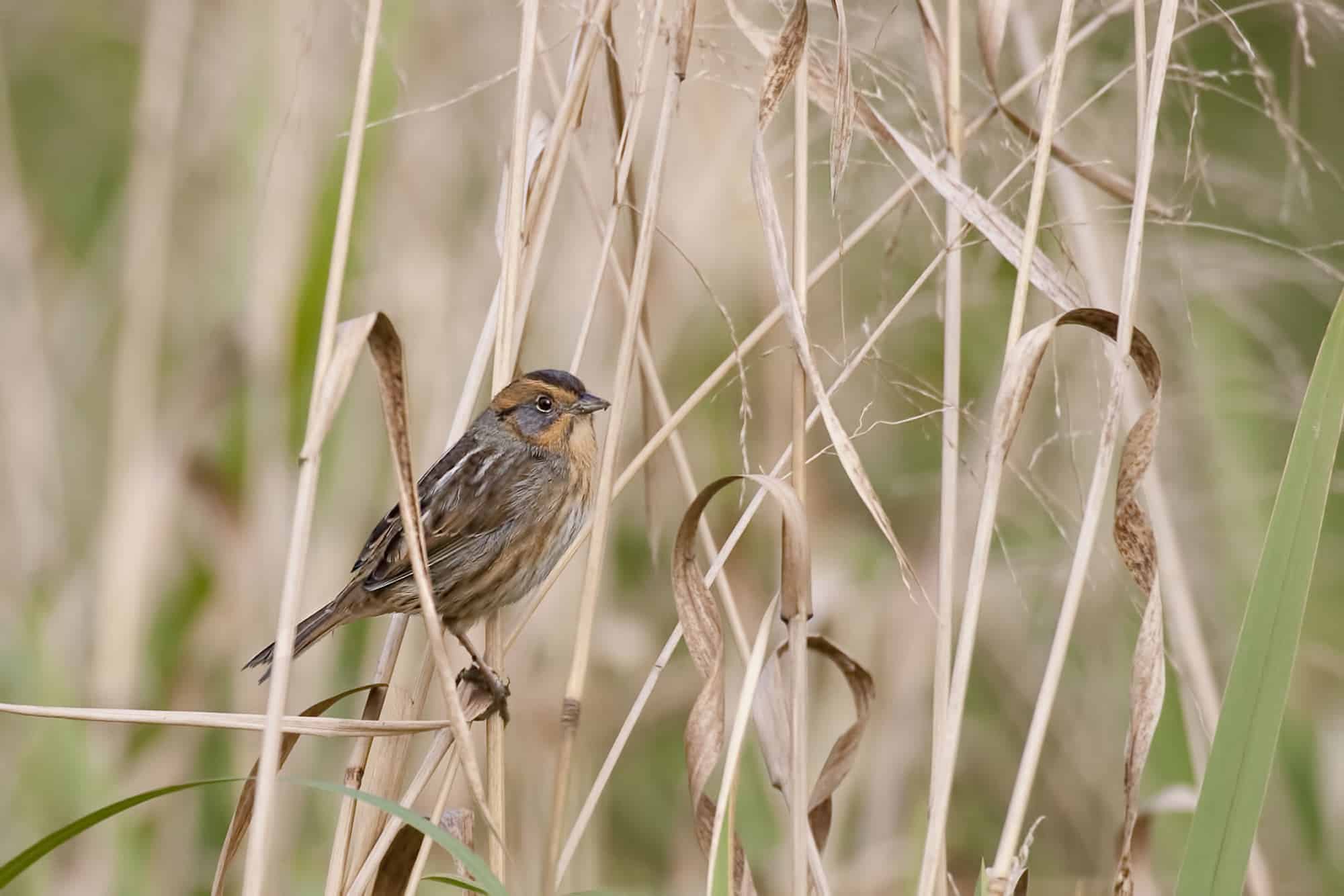
- Scientific Name: Ammospiza nelsoni
- Length: 4.3-5.1 in (11-13 cm)
- Weight: 0.6-0.7 oz (17-21 g)
- Wingspan: 6.5-7.9 in (16.5-20 cm)
Nelson’s sparrows are very similar to saltmarsh sparrows and were thought to be the same species until 1989! Now known to be distinct, Nelson’s sparrow’s distribution map had to be redrawn. It turns out they have very confined local residencies, but a large migratory range.
Although they overwinter on much of the east coast, they are absent in Delaware except during migration. Perhaps with the warming climate, however, their wintering range will extend further north to include Delaware, too.
Conclusion
Sparrows are widespread birds in Delaware, and many species can be attracted to your backyard by offering them food from your bird feeders. Other types of sparrows here prefer life out in grasslands and wetlands and require a dedicated effort to spot them.
Sparrows only make up a tiny part of the 400 species of birds in Delaware. To check out our guide to 25 of the most iconic species in the state click here. Can you guess which they’ll be?

